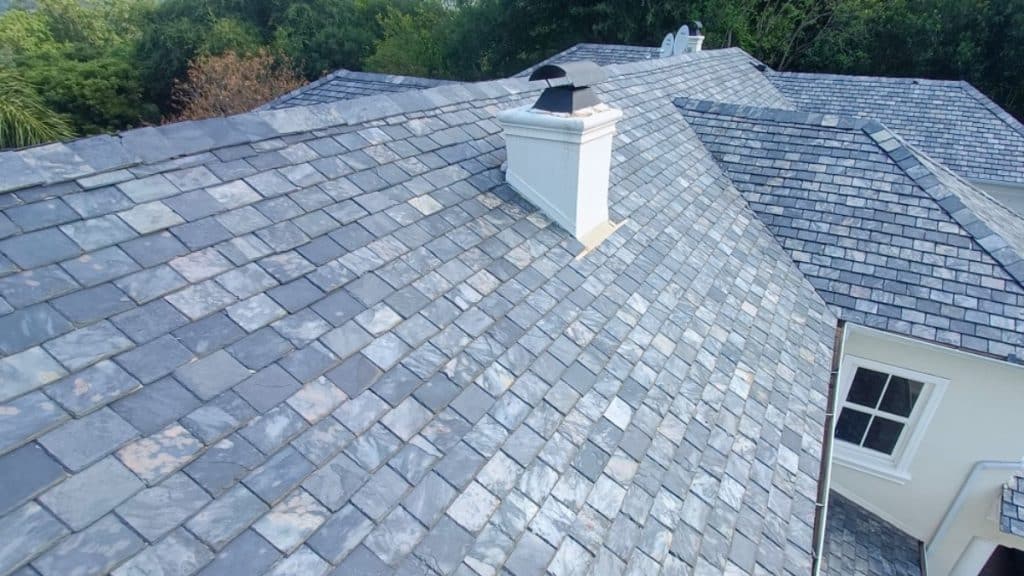Roof durability is among the highest priorities for homeowners when it comes to roofing. Although most contemporary roofing materials, such as asphalt shingles, metal, and even clay tiles, have to be replaced every 20 to 50 years, slate roofs stand in a league of their own. Lasting from 100 to 200 years (and sometimes more), slate has earned its place as the most resilient roofing material of all time.
But why exactly is slate so durable? Why are buildings constructed centuries ago, dating back to the 1800s, retaining their original slate roofs looking better than new ones? And should a slate roof be the investment of choice for you?
Let’s look deeper at the secret that allows slate roofs to be so long-lived and discuss the reasons why slate is regarded as the gold standard for roofing.
What Makes Slate Roofs So Long-Lasting?
Slate is a metamorphic rock that has been created under high pressure and heat over millions of years. The natural stone is very dense, long-lasting, and resistant to all types of weathering. In contrast to man-made roofing materials, slate does not easily deteriorate, making it one of the most durable roofing materials available.
Nevertheless, the installation of a slate roof necessitates expertise and specific techniques, and it is therefore critical to use the services of an experienced slate roofing contractor who will guarantee longevity, durability, and increased property value.
Here Are The Four Primary Reasons Why Slate Roofs Last For Centuries:
1. Unmatched Weather Resistance
One of the greatest dangers to roofing materials is the weather. Rain, snow, heat, and strong winds can destroy traditional roofs, but not slate.
- Waterproof: Slate does not soak up water like wood or asphalt shingles do. That means it won’t warp, rot, or crack, even in the most wet climates.
- Freeze & thaw protection: In cold climates, most roofs are damaged by repeated freezing and thawing. Since slate is dense and non-porous, it is not affected by temperature changes.
- Wind-resistant: Strong winds can tear off shingles and buckle metal panels, but a well-installed slate roof can endure winds of up to 110 mph—making it an excellent option for hurricane-prone regions.
- Hail & impact protection: In contrast to asphalt or metal roofs, which dent or shatter upon impact, slate is very hard and resistant, offering great protection against hailstorms.
2. Fireproof and Mold-Resistant
Fire is something that homeowners have a big fear of, yet slate is absolutely fireproof. Wood shingles, on the other hand, are extremely combustible, while asphalt shingles melt when put through intense heat. Since slate is a type of natural stone, it’s the most resistant to fire—it gives your house the ultimate fire safety.
Moreover, because slate is impervious to moisture, it eliminates the growth of mold, algae, and mildew—prevailing problems that afflict most roof materials. That translates to less maintenance and a longer roof lifespan.
3. Low Maintenance, Longest Lifespan
Most roofing materials are high maintenance and need periodic replacement. Asphalt shingles, for instance, shed granules over time, and metal roofs rust or corrode. Even tile roofs can crack and break from heat expansion.
Slate, however, stays practically the same for centuries. After being properly installed, a slate roof is virtually maintenance-free. The only maintenance homeowners must monitor is the replacement of occasional broken tiles, which is rare.
4. Environment Friendly and Sustainable
Most roofing materials, especially asphalt shingles, contribute millions of tons of waste to landfills every year. Since asphalt roofs need replacement every 20 to 30 years, they create a huge environmental footprint.
Slate roofs, however, last five to ten times longer than asphalt and are one of the most environment-friendly roofing options. Homeowners even recycle slate tiles from old buildings and reuse them, minimizing environmental impact even further.
How Long Can a Slate Roof Last?
The life expectancy of a slate roof varies based on the type of slate:
- Soft Slate: 50 to 125 years
- Hard Slate: 100 to 200+ years
Due to their remarkable longevity, it is not unusual to find centuries-old structures with their original slate roofs intact. Some old churches, government offices, and mansions still boast completely functional slate roofs installed during the 1800s—a testament to their longevity.
If you opt for a slate roof, you might never need to replace it during your lifetime!
Is a Slate Roof Worth the Investment?
Though slate roofs are among the most costly roofs to install, they provide unrivaled long-term value.
- Asphalt shingles’ lifespan is 20-30 years, and replacement is needed several times.
- Metal Roofs’ lifespan is 40-70 years, and replacement is perhaps needed once.
- Clay Tile’s lifespan is 50-100 years, and replacement is perhaps needed once.
- Slate Roof life span is 100-200+ years, and replacement is probably NEVER needed.
With a slate roof, you eliminate the exorbitant costs of roof replacements in the future. It’s an upfront investment that rewards you across generations.
Additional Benefits of Slate Roofing
- Increases Home Value – Slate-roofed houses command a higher price because they are long-lasting and beautiful.
- Maximum Energy Efficiency – Slate naturally insulates, keeping temperatures stable indoors and saving energy expenses.
- Enduring Beauty – Slate roofs present a timeless, sophisticated look that increases curb appeal on any house.
Last Thoughts: The Roof That Stands the Test of Time
If you’re looking for a roofing solution that lasts a lifetime (or longer), a slate roof is the ultimate choice. With its unmatched durability, fireproof nature, and low maintenance needs, it’s no wonder castles, cathedrals, and historic mansions around the world still have their original slate roofs intact.
Selecting slate means you’ll never have to replace your roof again, so it’s the most economical and eco-friendly roofing option in the long term.
